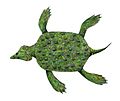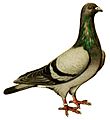Placodonts facts for kids
Quick facts for kids Placodonts |
|
|---|---|
 |
|
| Placodus, the main type of placodont | |
| Scientific classification |
|
| Kingdom: | Animalia |
| Phylum: | Chordata |
| Class: | Reptilia |
| Superorder: | †Sauropterygia |
| Clade: | †Placodontiformes |
| Order: | †Placodontia Cope, 1871 |
| Subgroups | |
|
|
Placodonts (which means "Tablet teeth") were an extinct group of marine reptiles. They lived during the Triassic period, which was a very long time ago. These creatures died out completely at the end of the Triassic period. They belonged to a larger group called Sauropterygia, which also includes the famous plesiosaurs.
Most placodonts were about 1 to 2 meters (3 to 6.5 feet) long. However, some of the biggest ones could grow up to 3 meters (nearly 10 feet) long! The first placodont fossil was found in 1830. Their fossils have been discovered in many places, including central Europe, North Africa, the Middle East, and China.
Contents
What Were Placodonts Like?
The earliest placodonts, like Placodus, lived in the early to middle Triassic period. They looked a bit like barrel-shaped lizards. You could compare them to today's marine iguana, but much bigger! Marine iguanas eat algae, but placodonts had a different diet. They ate molluscs, which are creatures with shells, like clams and snails. Because of this, placodonts had strong, flat teeth perfect for crushing shells.
At first, their large size probably helped them stay safe from the biggest sea predators, like sharks. But as time went on, other meat-eating reptiles, such as ichthyosaurs and nothosaurs, started living in the seas. To protect themselves, later placodonts grew bony plates on their backs.
By the Late Triassic, these bony plates had grown so much that some placodonts, like Henodus and Placochelys, looked a lot like modern sea turtles. Other placodonts, like Psephoderma, also developed plates. But their plates were connected in a way that looked more like the shell of a horseshoe crab. These changes are great examples of convergent evolution. This means different animals develop similar features even though they are not closely related.
Where Did They Live?
Placodonts had very dense bones and heavy armor. This made them quite heavy, so they probably couldn't float easily in the ocean. It would have taken a lot of energy for them to swim up to the surface. Because of this, and the type of rock where their fossils are found, scientists believe they lived in shallow waters. They probably stayed close to the seabed, not in the deep ocean.
What Did They Eat?
Placodonts mainly ate marine bivalves (like clams), brachiopods, and other small creatures without backbones. They are famous for their large, flat, and sometimes sticking-out teeth. They used these teeth to crush the shells of the molluscs and brachiopods they found on the seafloor. This way of eating hard-shelled food is called durophagy. Their teeth were very thick and strong, perfect for crushing thick shells. This is another way they were similar to walruses, which also crush shells.
However, one placodont called Henodus was different. It had special teeth that looked like the baleen plates of some whales. This suggests that Henodus was a filter feeder. This means it would filter tiny bits of food from the water. Another placodont, Atopodentatus, also had a wide jaw shape. Scientists think it was a herbivore, meaning it ate plants, possibly by filtering plant matter from the seabed.
For a long time, people thought placodonts only lived in the western Tethys Ocean. But then, the discovery of Sinocyamodus xinpuensis in China showed that they lived in other parts of the world too!
Placodont Family Tree
Placodonts belong to the class Reptilia, which includes all reptiles. They are part of the superorder Sauropterygia.
Within the Placodontia group, there are several families and genera:
- Genus Atopodentatus?
- Genus Pararcus
- Superfamily Placodontoidea
- Family Paraplacodontidae
- Genus Paraplacodus
- Family Placodontidae
- Genus Placodus
- Family Paraplacodontidae
- Superfamily Cyamodontoidea
- Genus Sinocyamodus
- Genus Psephosauriscus
- Genus Psephosaurus
- Family Henodontidae
- Genus Henodus
- Genus Parahenodus
- Family Cyamodontidae
- Genus Cyamodus
- Genus Protenodontosaurus
- Family Placochelyidae
- Genus Glyphoderma
- Genus Placochelys
- Genus Psephosauriscus
- Genus Psephochelys
- Genus Psephoderma
There was also a group called Placodontiformes. This group includes Palatodonta and Placodontia. Palatodonta was a marine reptile from the early Middle Triassic. It was very similar to placodonts, but its teeth were small and pointed, not broad and flat.
Another group, Helveticosauroidea, was once thought to be a basic type of placodont. Its only member was Helveticosaurus. However, scientists now believe Helveticosaurus was not a placodont. It might have been an unusual member of the Archosauromorpha group instead.
Images for kids
See also
 In Spanish: Placodontos para niños
In Spanish: Placodontos para niños









